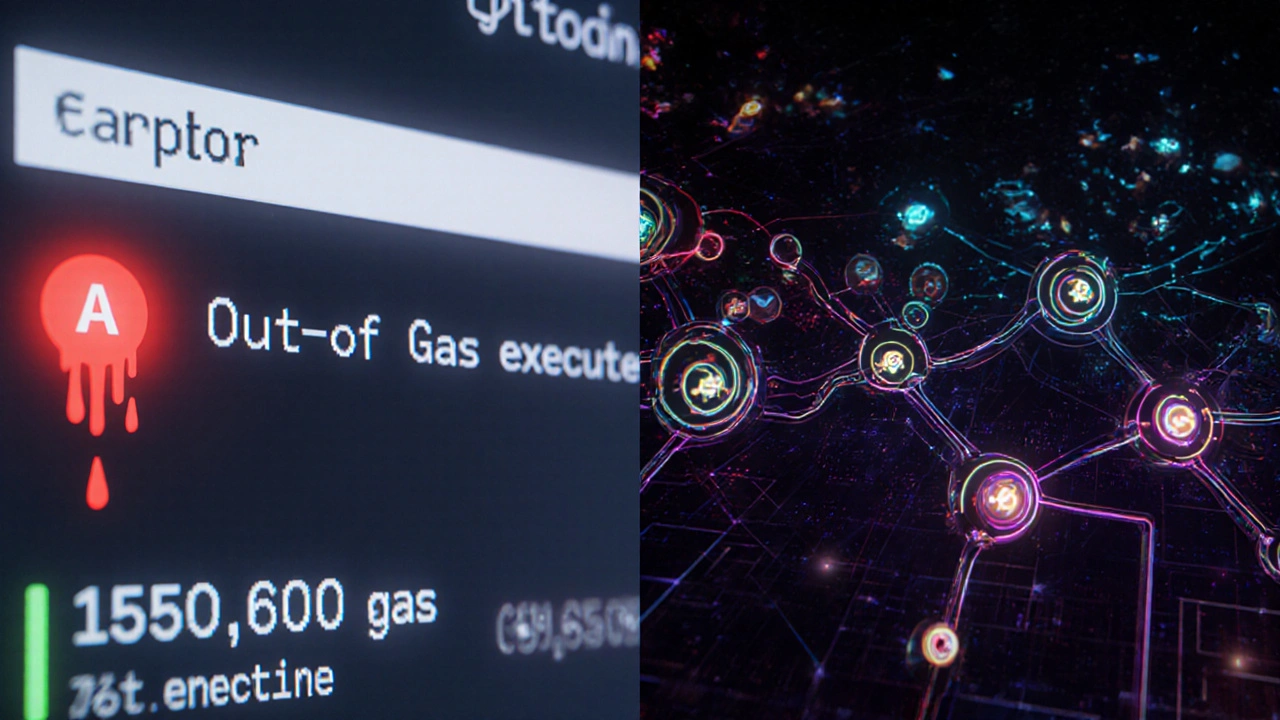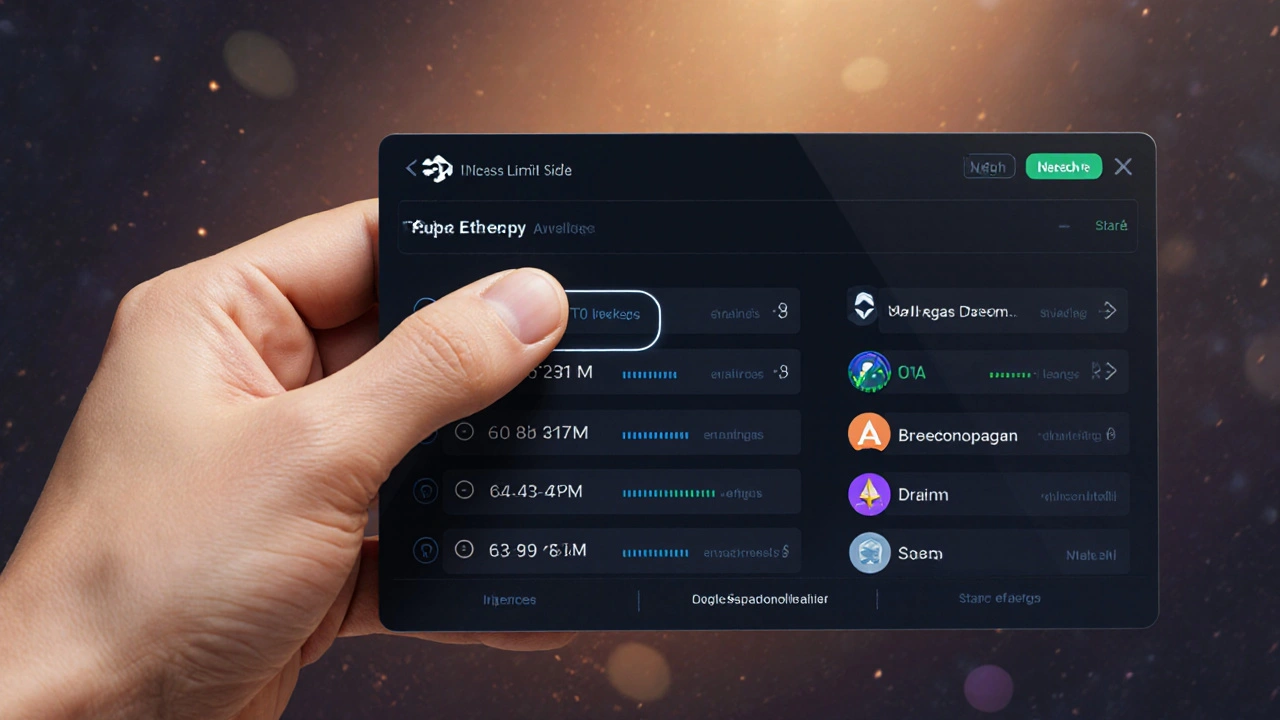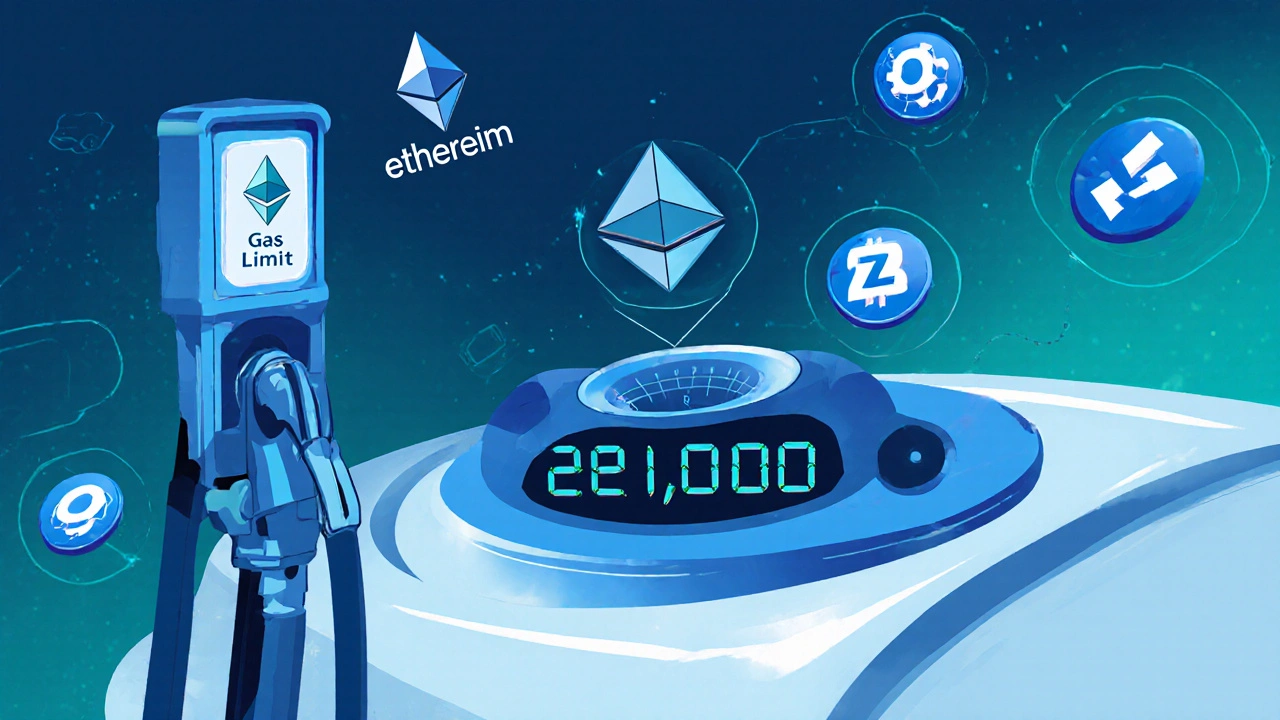When you send Ether or interact with a smart contract on Ethereum, something invisible but crucial happens behind the scenes: your transaction needs gas. And the gas limit is what tells the network exactly how much gas you’re willing to spend. Without setting the right gas limit, your transaction might fail, get stuck, or cost you more than you expected.
What exactly is gas limit?
The gas limit is the maximum amount of gas you’re willing to pay for a transaction on Ethereum. Think of it like setting a budget before filling up your car. You don’t want to run out of fuel halfway to your destination, but you also don’t want to overpay for gas you don’t use.
Each operation on Ethereum - whether it’s sending ETH, swapping tokens, or locking funds in a DeFi protocol - requires a certain amount of computational work. That work is measured in gas units. The gas limit is your cap on how many units you’ll allow the network to use for your transaction.
If your transaction uses less gas than your limit, you only pay for what you used. The leftover gas is refunded. But if your transaction needs more gas than your limit, it stops mid-execution and fails. You still pay for the gas already used, but nothing gets done.
Why does Ethereum need gas?
Ethereum isn’t just a digital currency. It’s a global computer. Every time a smart contract runs - like when you stake ETH, trade on Uniswap, or mint an NFT - thousands of nodes around the world have to verify and execute that code. That takes time, energy, and computing power.
Gas is the price tag for that computing power. It keeps the network secure and prevents spam. Without gas, bad actors could flood the network with endless loops or infinite requests, slowing everything down or crashing it entirely. Gas ensures that every action has a cost, making abuse expensive and impractical.
The gas price (measured in gwei) is what you pay per unit of gas. The gas limit is how many units you’re okay with spending. Multiply them together, and you get your total transaction fee.
How is gas limit different from gas price?
People often confuse gas limit and gas price. They’re two separate numbers with different jobs.
- Gas limit = how much gas your transaction is allowed to use (like the size of your gas tank).
- Gas price = how much you’re willing to pay per unit of gas (like the price per gallon at the pump).
For example:
- Gas limit: 21,000
- Gas price: 50 gwei
- Total fee: 21,000 × 50 = 1,050,000 gwei = 0.00105 ETH
If you set your gas limit too low - say, 10,000 - and your transaction actually needs 21,000, it fails. You lose the 10,000 gas you paid for, and nothing happens. But if you set it too high - say, 1,000,000 - you’re not overpaying on gas price, but you’re tying up more computational resources than needed. The network doesn’t charge extra for unused gas, but it does slow down block processing for everyone else.
What are typical gas limits for common Ethereum actions?
Not all transactions are the same. Some are simple. Others are complex. Here’s what you’re likely to see in 2025:
- Basic ETH transfer: 21,000 gas - the simplest possible transaction.
- Token swap (Uniswap, SushiSwap): 100,000-200,000 gas - involves multiple smart contract calls.
- Staking ETH (via Lido, Rocket Pool): 200,000-300,000 gas - interacts with staking contracts and validator logic.
- Minting an NFT: 300,000-500,000 gas - depends on metadata size and contract complexity.
- DeFi deposit/withdrawal (Aave, Compound): 150,000-400,000 gas - multiple approvals and state changes.
- Complex smart contract interaction: 500,000+ gas - could go over 1 million for advanced DeFi strategies.
Most wallets like MetaMask, Coinbase Wallet, or Rainbow show you an estimated gas limit based on what similar transactions have used. But these are just estimates. If you’re doing something unusual, you might need to adjust manually.

What happens if you set the gas limit too low?
If your gas limit is too low, your transaction runs out of gas before finishing. This is called an out-of-gas error. The transaction fails. You don’t get your ETH or tokens back. And you lose the gas you already spent.
Imagine ordering a pizza and only paying for the crust. The delivery person shows up, starts unpacking the box, but runs out of money halfway through. They can’t finish, but you still paid for the crust. That’s an out-of-gas error.
Common scenarios:
- You try to swap a token but set gas limit to 21,000 - it fails because swaps need more.
- You interact with a new DeFi protocol and accept the default limit - it’s too low for their contract.
- You’re sending ETH to a contract address (not a wallet) and forget it needs more gas than a simple transfer.
There’s no way to recover a failed transaction. The only thing you can do is resend it with a higher gas limit.
What happens if you set the gas limit too high?
Setting a high gas limit won’t make your transaction faster or more likely to succeed. It just means you’re allowing more room for error. You won’t pay more than the actual gas used - the rest gets refunded.
So why not set it to 10 million? Because:
- It makes your transaction look suspicious to miners and validators.
- It can delay inclusion in a block if the network is congested - miners prioritize transactions with better gas efficiency.
- It’s wasteful. Even if you get a refund, you’re using more network resources than needed.
Think of it like renting a 10-seater van to drive yourself to the grocery store. You’ll pay for the van, but you only use one seat. You get your groceries, sure - but you didn’t need the extra space.
How to set the right gas limit
Most wallets auto-calculate gas limits based on historical data and contract analysis. In most cases, you don’t need to touch it. But here’s when you should:
- You’re interacting with a new or unknown smart contract.
- Your transaction failed with an out-of-gas error.
- You’re doing a complex DeFi strategy (e.g., yield farming with multiple steps).
When you need to adjust:
- Check what the wallet suggests as the default limit.
- Look up similar transactions on Etherscan using the contract address.
- Add 20-30% buffer if you’re unsure.
- Never go below the default unless you’re certain.
For example, if MetaMask suggests 150,000 gas for a token swap, try 180,000 if you’ve had failures before. If you’re still getting out-of-gas errors, check the contract’s documentation or community forums - someone else has probably run into this.

Gas limits and Ethereum upgrades
Since the Merge in 2022, Ethereum no longer uses proof-of-work. Miners are gone. Validators now process transactions, and they still care about gas limits - but their incentives are different.
Validators still prioritize transactions with higher gas prices, but they also prefer efficient gas usage. A transaction with a 500,000 gas limit that only uses 120,000 is cleaner than one with a 1,000,000 limit that uses 990,000. It leaves more room for other transactions in the block.
Upgrades like EIP-1559 (2021) changed how fees work, but didn’t change how gas limits function. The limit is still your cap. The base fee and priority fee are separate.
Future upgrades like Proto-Danksharding (2025) will make data cheaper, which might reduce gas costs for complex transactions - but the gas limit concept remains unchanged.
Common mistakes and how to avoid them
Here are the top gas limit mistakes users make in 2025:
- Using the same limit for everything - sending ETH uses 21,000, but swapping tokens needs 10x more.
- Ignoring failed transactions - if one swap fails, don’t just retry with the same settings.
- Trusting random gas estimators - some third-party tools give bad estimates. Stick to your wallet or Etherscan.
- Setting it too high to "ensure success" - it doesn’t help. You’ll pay the same, just waste network capacity.
- Not checking contract addresses - sending to a token contract instead of a wallet? That needs more gas.
Pro tip: Always check the transaction details before hitting confirm. If the gas limit is below 100,000 for anything other than a simple ETH transfer, pause and double-check.
Final thoughts
Gas limit isn’t magic. It’s just a safety mechanism - your way of saying, "I’m okay with spending up to this much to get this done." Understanding it means you’re no longer at the mercy of your wallet’s defaults. You can troubleshoot failures, save money, and move confidently across DeFi protocols.
You don’t need to memorize exact numbers. But knowing that a basic transfer needs 21,000, a swap needs 100,000+, and complex contracts can need 500,000+ gives you the mental framework to act smartly. When in doubt, go slightly higher than the wallet suggests. When in doubt again, check Etherscan for similar transactions.
Gas limit is one of the first real signs you’re not just a crypto user - you’re becoming a blockchain participant.
What happens if my gas limit is too low?
If your gas limit is too low, your transaction will run out of gas before completing and fail. You’ll lose the gas you already spent, but no changes will be made to your funds or balances. You’ll need to resend the transaction with a higher gas limit.
Can I get my gas back if I set the limit too high?
Yes. You only pay for the actual gas your transaction uses. Any unused gas is automatically refunded to your wallet. Setting a high gas limit doesn’t mean you pay more - it just gives the transaction room to complete without failing.
Is gas limit the same as transaction fee?
No. Gas limit is the maximum amount of gas you’re allowing your transaction to use. The transaction fee is the actual cost, which is gas limit multiplied by gas price. You pay for gas used, not gas limit.
Why does a simple ETH transfer need 21,000 gas?
Even a simple ETH transfer requires the Ethereum Virtual Machine to update two accounts: deducting from the sender and adding to the receiver. That’s a fixed computational cost. 21,000 gas is the standard amount assigned to this basic operation.
Do I need to adjust gas limit manually?
Usually not. Wallets like MetaMask estimate it automatically. But if you’re interacting with a new DeFi protocol or had a failed transaction, you may need to increase the limit manually. Always check Etherscan for similar transactions before adjusting.


Adithya M
November 6, 2025 AT 19:56Bro this is basic stuff but honestly most newbies don't get it. I saw someone try to swap $SOL on Uniswap with 21k gas limit and wonder why it failed. You ain't sending ETH to a friend here. Smart contracts ain't magic, they need fuel. Set it higher or GTFO.
Jessica McGirt
November 8, 2025 AT 18:37I appreciate how clearly this breaks down gas limit vs. gas price. So many people conflate the two, and it leads to unnecessary panic when transactions fail. The pizza analogy? Perfect. I’ll be sharing this with my crypto beginners’ study group tomorrow.
Donald Sullivan
November 10, 2025 AT 04:17LMAO you think 21k is enough for anything? I’ve seen people try to interact with a Yearn vault with 50k gas and act shocked when it fails. Wallets are lazy. They guess. You gotta check Etherscan. If you’re not manually adjusting, you’re not serious.
Tina van Schelt
November 10, 2025 AT 10:19Imagine gas limit like ordering a burrito - you pick the size: small (21k), medium (100k), or the whole damn burrito bowl with extra guac and sour cream (500k+). You don’t want to run out halfway through the beans, but you also don’t need to pay for a burrito that fills a whole table. It’s not about being rich - it’s about being thoughtful.
Ronak Khandelwal
November 10, 2025 AT 21:27Gas limit is like life - you set boundaries so you don’t burn out. 🌱 You don’t need to max out your tank just to drive to the corner store. But if you’re going on a road trip across the desert? Bring extra. Ethereum’s just teaching us balance. And patience. And that sometimes, failure is just a nudge to try again smarter. 💪
Jeff Napier
November 11, 2025 AT 23:53Gas limit is a scam. The whole system is rigged. Miners used to control it. Now validators do. Who’s to say they’re not hiding extra fees in the code? You think your refund is real? Nah. They just show you a fake number. You’re being played. The blockchain’s not decentralized - it’s a corporate puppet show with fancy math.
Sibusiso Ernest Masilela
November 13, 2025 AT 04:42Pathetic. You call this education? 21k gas? For a transfer? Please. Real developers don’t use MetaMask. They write raw transactions in Solidity with custom gas estimation. You’re still using a GUI like a toddler. If you can’t calculate gas manually, you shouldn’t be touching a wallet at all.
Gina Grub
November 14, 2025 AT 05:17Gas limit isn't a metric it's a social contract. Validators optimize for efficiency not fairness. The fact you think refund = justice is naive. You're not paying for computation you're paying for inclusion. And if your tx is bloated? You're the spammer. Welcome to the new economy where your incompetence is monetized.
Nathan Jimerson
November 14, 2025 AT 23:27Great breakdown. I used to panic every time a transaction failed. Now I just bump the limit by 20% and move on. It’s not perfect, but it’s peaceful. Ethereum’s complicated, but you don’t need to overthink it to use it well.
Meredith Howard
November 16, 2025 AT 20:51Thank you for the thorough explanation. I found the analogy between gas limit and vehicle fuel capacity particularly illuminating. It is my understanding that the refund mechanism ensures economic efficiency and prevents unnecessary resource consumption. This aligns with principles of sustainable system design
Yashwanth Gouravajjula
November 17, 2025 AT 22:4321k for ETH. 100k+ for swap. 500k for NFT. Done.
Kevin Hagerty
November 19, 2025 AT 15:46Wow what a masterpiece of condescension. You wrote a textbook on how to not get scammed by your own wallet. Meanwhile I’m over here using 10 million gas limit just to spite the system. Who needs efficiency when you got vibes? 💅
Jessica McGirt
November 20, 2025 AT 23:54Actually, the part about validators preferring efficient gas usage is key. I read a paper last week that showed bloated gas limits can delay inclusion even if the price is high. It’s not just about cost - it’s about network hygiene. Thanks for highlighting that.